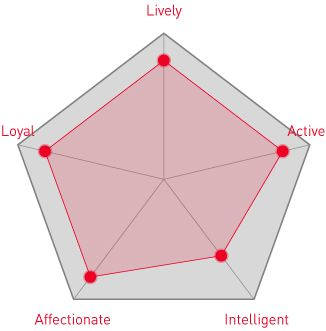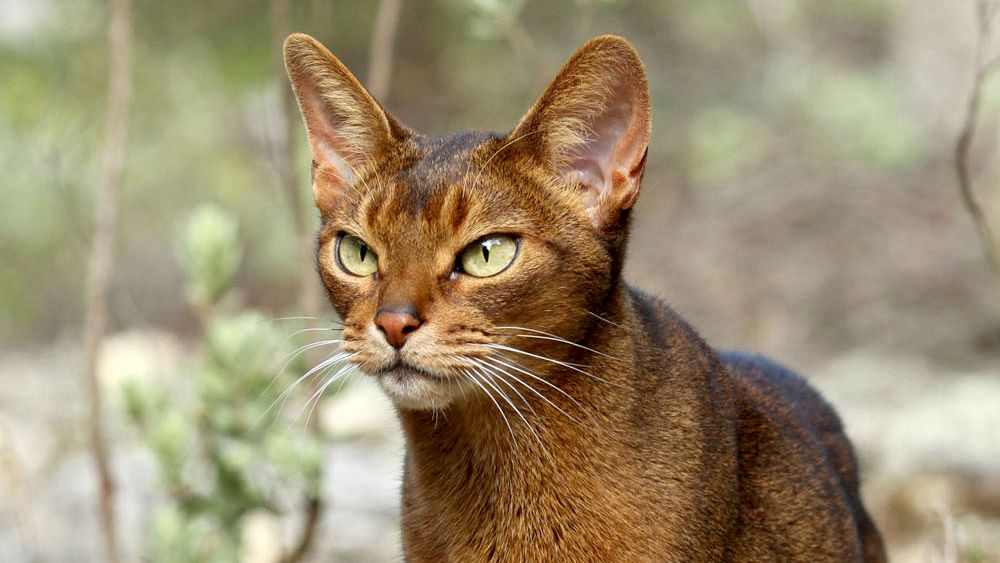Let's talk Abyssinians
An elegant mini-mountain lion of a cat, the Abyssinian is hard to miss, with their ticked coat and lithe body. Agile to a fault, this is a cat that’s always in motion, which suits them just fine. Robust as well, the Abyssinian cat is known for vigorous health throughout their life. The breed is highly playful, earning them the nickname ‘Clown of the Cat Kingdom’. Look forward to hours of fun from this winsome cat, which they will return with loyalty and loads of affection.
Official name: Abyssinian
Origins: Ethiopia

| Shedding level: |  |
Warm weather? | |
| Energy level (high, low, medium): * | High | Family pet? * |  |
| Compatibility with other pets: |  |
* We advise against leaving pets alone for long stretches. Companionship can prevent emotional distress and destructive behaviour. Speak to your veterinarian for recommendations.
Every pet is different, even within a breed; this snapshot of this breed’s specifics should be taken as an indication.
For a happy, healthy and well-behaved pet, we recommend educating and socialising your pet as well as covering their basic welfare, social and behavioural needs.
Pets should never be left unsupervised with a child.
All domestic pets are sociable and prefer company. However, they can be taught to cope with solitude from an early age. Seek the advice of your veterinarian or trainer to help you do this.


| Baby cat: | Birth to 4 months |
| Growing kitten: | 4 to 12 months |
| Adult: | 1 to 7 years |
| Mature: | 7 to 12 years |
| Senior: | From 12 years |

1/7
Origins of the breed
For many enthusiasts, the Labrador Retriever remains one of the most popular all-round dogs worldwide. It’s thought that Labrador Retrievers originated from the coast of Newfoundland, Canada, where fishermen used dogs of this appearance to retrieve fish. The breed as we know it today, however, was established by the British in the early 1800’s.
The Labrador Retriever Club was founded in 1916 and the first standard followed soon after, predominantly tailored to working Labrador Retrievers who found early fame, having been originally introduced to the U.K. in the late 1800’s by Col Peter Hawker and the Earl of Malmesbury.

2/7
2 facts about Abyssinians
1. Reaches for new heights
Many cats are highly athletic but the Abyssinian just might rank first when it comes to scaling heights: They’ve been known to jump as high as six feet in the air, and like to be as high as possible in their surroundings. Reserve a place for them on the top bookshelf so they feel like queen of the castle.
2. Been around a while
The first traces of the Abyssinian cat were uncovered by archaeologists as mummified versions from Ancient Egypt. Images of Abyssinian-like cats have been found on the tombs of the Pharaohs as well; even Ramses II – who reigned in the 12th century B.C. – was said to have had an Abyssinian. 4,000 years later, the breed is still around and as popular as ever.
History of the breed
The Abyssinian cat has a storied history, reaching back many millennia: The breed has been among us for 4,000 years, with images of similar cats found on the tombs of the Pharaohs of ancient Egypt; it’s rumoured that even Ramses II kept an Abyssinian in the 12th century B.C. Mummified cats have also been found by archaeologists in ancient Egypt bearing a strong resemblance to the breed we know today.
Information on the Abyssinian however, is disputed, especially their origin. They are named for Abyssinia, formerly Ethiopia, whom Great Britain defeated in the Abyssinian War of 1868. One Marshall Sir Robert Napier, returned home to England with a kitten named Zula, thus launching the breed into the U.K. After the cat was exhibited in 1871 at London’s Crystal Palace, their popularity soared even further. The Abyssinian then gained official breed status in 1882 before making their way to the U.S. after the turn of the 20th century.
The Abyssinian breed remains among the top five most popular in the rankings of both the Cat Fancier’s Association and the International Cat Association.

4/7
From head to tail
Physical characteristics of Abyssinians
1. Ears
Very large, pricked ears, fairly pointed, tilted slightly forward.
2. Head
Distinctive wedge-shaped head, slightly rounded.
3. Body
Athletic, slender body.
4. Tail
Long, tapered tail, thick at base, proportional to body.
5. Coat
Coat is short, very compact, incredibly soft.

5/7
Things to look out for
From specific breed traits to a general health overview, here are some interesting facts about your Abyssinian

6/7
Caring for your Abyssinian
Grooming, training and exercise tips
Care for your Abyssinian is easy since their very dense, short coat takes little time to groom; rubbing them down with a cold damp cloth can keep their coat shiny, and baths need be given only as-needed. Nails should be kept trim to prevent undue wear and tear.
Exercise for your Abyssinian will also be a breeze since they are rarely at rest. They do enjoy jumping to high places so make sure your residence is cat-friendly—meaning cherished family heirlooms are out of reach. The Abyssinian’s dynamic personality means training them to behave won’t be hard. They do have a tender side but will require reinforcement. Highly playful and energetic, the Abyssinian has a healthy lifespan, too. Making sure they have the tallest cat tree and plenty of toys at their disposal will keep them content.
7/7
All about Abyssinians
The Abyssinian cat is a great breed, especially for first-time cat owners. They are as cuddly as they are playful, and as a very high-energy breed, needs downtime after hours of running around. Prepare for a cat who will follow you everywhere and settle in once you sit down—but not before they’re ready.
The breed can live on average up to 15 years, which is a shorter lifespan than many, with the Abyssinians’s rambunctious personality keeping them on the go at all times. Keeping them in good health then is essential. The breed remains kitten-like into their older years.
Tailored nutrition for your Labrador Retriever
translations.feature.breeds.otherbreeds
Read more on this topic

Your guide to adopting a cat

The cost of owning a cat

Should I adopt a cat or buy a kitten?

Should I choose a pure breed or mixed breed cat?

Your guide to buying a kitten
Sources
1 - Veterinary Centers of America https://vcahospitals.com/
2 - Royal Canin Cat Encyclopaedia. Ed 2010 and 2020
3 - Banfield Pet Hospital https://www.banfield.com/
4 - Royal Canin BHN Product Book





